
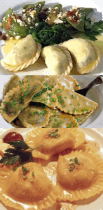
Carinthia’s (the region bordering Italy) best-known dish is Kasnudel, The pasta dough is rolled flat, fashioned into fist-sized pockets and filled with a blend of various delicacies. The classical ”Kasnudel” contain curds and mint, but there are variants with other fillings – meat, or spinach, potatoes and mushrooms, or (in a sweet incarnation) prunes. Another type of Carinthian ”Nudel” is the ”Schlutzkrapferl”, a smaller pastry pocket with a filling of surcream, potatoes and fresh herbs.
Originally a Lenten specialty in the Swabian area of Germany these pasta pockets are usually filled with minced meat, spinach, bread crumbs and onions and flavored with parsley. Maultaschen are served year-round, but especially in the days leading up to Easter.
The legend goes that maultaschen were originally invented in order to allow Swabians to keep eating meat during Lent by concealing it in the pasta shell and the spinach filling.
For more information look at:
Maultaschen
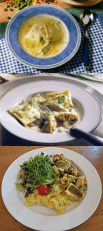
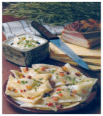
The bryndzové pirohy is a kind of Slovak ravioli. Potato-based pasta dough is rolled out thin, cut into smallish pieces and then stuffed with a mixture of more potatoes and bryndza. The little packets are then boiled till tender and then topped with sour cream and chunks of bacon.
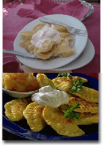
The polish contribution to the world of stuffed dumplings is the pierogi. Pierogis are usually filled with sauerkraut and/or mushrooms, meat, potato and/or savory cheese. They are boiled and then sauteed before serving. The sweet versions come filled with sweet curd cheese with a touch of vanilla, or blueberries or other fruits -- optionally topped with sour cream, and sugar.
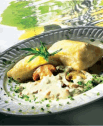
The Slovenian version of the burek is very similar to that found in other parts of the Balkan. The Slovenian kitchen however has an interesting dish called struklji -- a rolled pancake with savory filling that is served boiled.